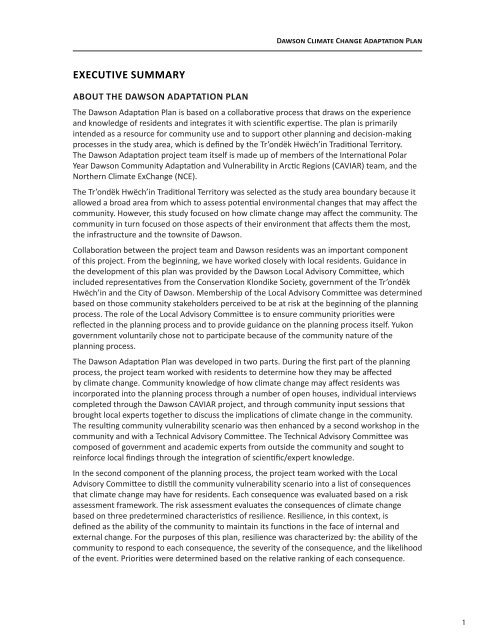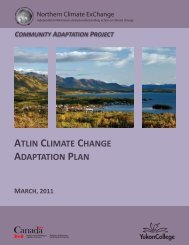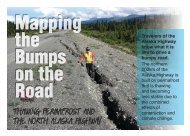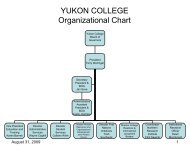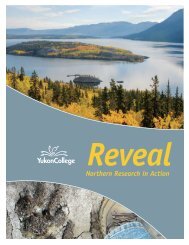Dawson Climate Change Adaptation Plan, Revised ... - Yukon College
Dawson Climate Change Adaptation Plan, Revised ... - Yukon College
Dawson Climate Change Adaptation Plan, Revised ... - Yukon College
You also want an ePaper? Increase the reach of your titles
YUMPU automatically turns print PDFs into web optimized ePapers that Google loves.
<strong>Dawson</strong> <strong>Climate</strong> <strong>Change</strong> <strong>Adaptation</strong> <strong>Plan</strong>EXECUTIVE SUMMARYABOUT THE DAWSON ADAPTATION PLANThe <strong>Dawson</strong> <strong>Adaptation</strong> <strong>Plan</strong> is based on a collaborative process that draws on the experienceand knowledge of residents and integrates it with scientific expertise. The plan is primarilyintended as a resource for community use and to support other planning and decision-makingprocesses in the study area, which is defined by the Tr’ondëk Hwëch’in Traditional Territory.The <strong>Dawson</strong> <strong>Adaptation</strong> project team itself is made up of members of the International PolarYear <strong>Dawson</strong> Community <strong>Adaptation</strong> and Vulnerability in Arctic Regions (CAVIAR) team, and theNorthern <strong>Climate</strong> Ex<strong>Change</strong> (NCE).The Tr’ondëk Hwëch’in Traditional Territory was selected as the study area boundary because itallowed a broad area from which to assess potential environmental changes that may affect thecommunity. However, this study focused on how climate change may affect the community. Thecommunity in turn focused on those aspects of their environment that affects them the most,the infrastructure and the townsite of <strong>Dawson</strong>.Collaboration between the project team and <strong>Dawson</strong> residents was an important componentof this project. From the beginning, we have worked closely with local residents. Guidance inthe development of this plan was provided by the <strong>Dawson</strong> Local Advisory Committee, whichincluded representatives from the Conservation Klondike Society, government of the Tr’ondëkHwëch’in and the City of <strong>Dawson</strong>. Membership of the Local Advisory Committee was determinedbased on those community stakeholders perceived to be at risk at the beginning of the planningprocess. The role of the Local Advisory Committee is to ensure community priorities werereflected in the planning process and to provide guidance on the planning process itself. <strong>Yukon</strong>government voluntarily chose not to participate because of the community nature of theplanning process.The <strong>Dawson</strong> <strong>Adaptation</strong> <strong>Plan</strong> was developed in two parts. During the first part of the planningprocess, the project team worked with residents to determine how they may be affectedby climate change. Community knowledge of how climate change may affect residents wasincorporated into the planning process through a number of open houses, individual interviewscompleted through the <strong>Dawson</strong> CAVIAR project, and through community input sessions thatbrought local experts together to discuss the implications of climate change in the community.The resulting community vulnerability scenario was then enhanced by a second workshop in thecommunity and with a Technical Advisory Committee. The Technical Advisory Committee wascomposed of government and academic experts from outside the community and sought toreinforce local findings through the integration of scientific/expert knowledge.In the second component of the planning process, the project team worked with the LocalAdvisory Committee to distill the community vulnerability scenario into a list of consequencesthat climate change may have for residents. Each consequence was evaluated based on a riskassessment framework. The risk assessment evaluates the consequences of climate changebased on three predetermined characteristics of resilience. Resilience, in this context, isdefined as the ability of the community to maintain its functions in the face of internal andexternal change. For the purposes of this plan, resilience was characterized by: the ability of thecommunity to respond to each consequence, the severity of the consequence, and the likelihoodof the event. Priorities were determined based on the relative ranking of each consequence.1


